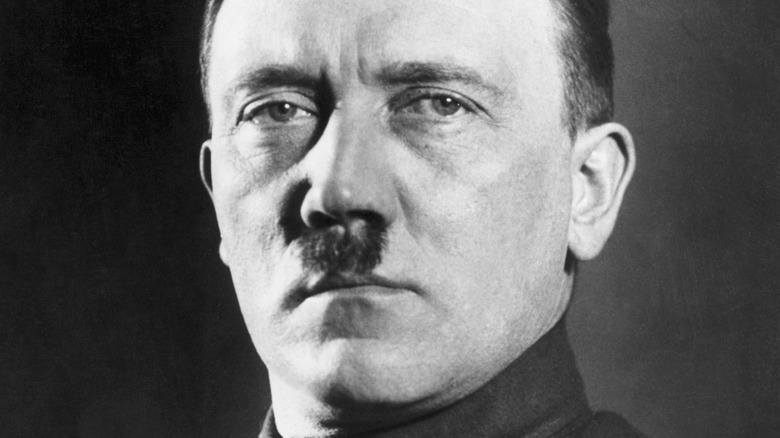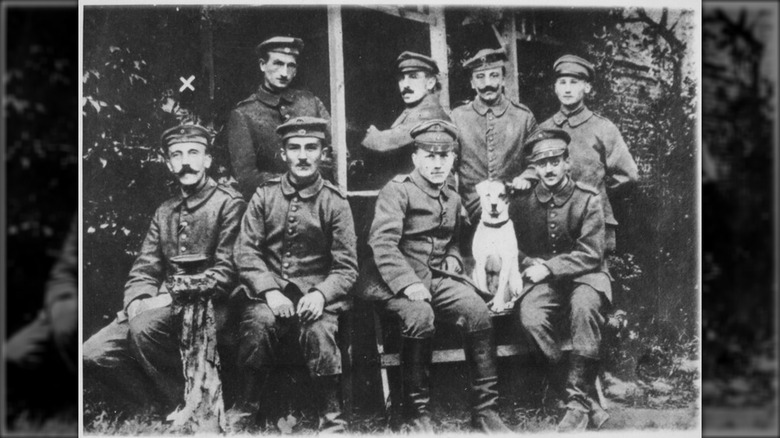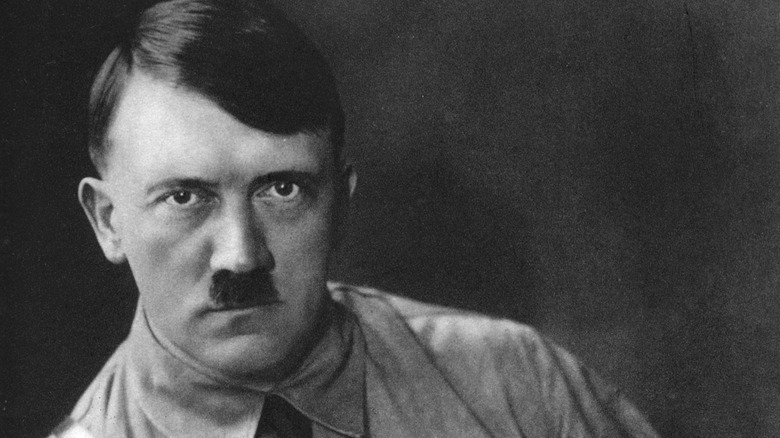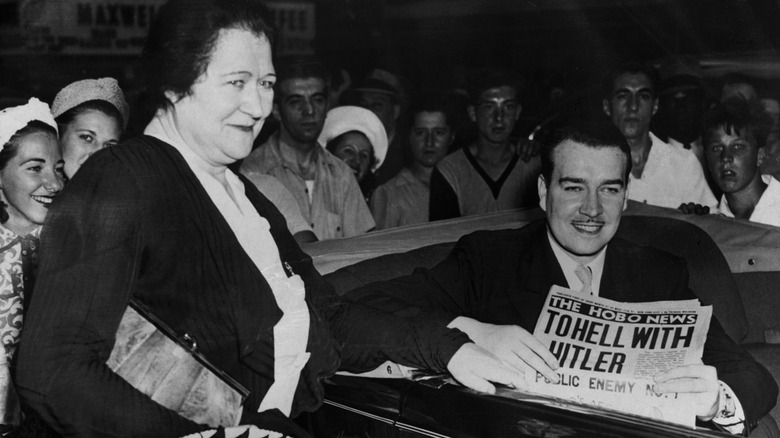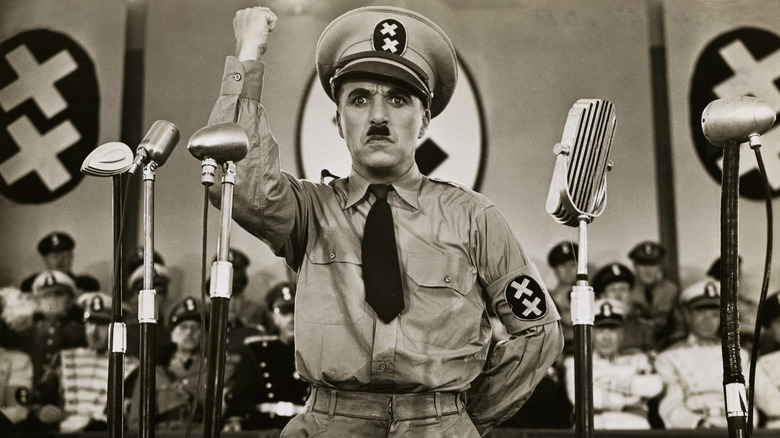The Biggest Theories About Hitler's Infamous Mustache
National Socialist (Nazi) Party leader Adolf Hitler came to power in Germany in 1933, after which his image hung in school classrooms and offices, and appeared on stamps and propaganda material throughout the country. He turned himself into an icon, but even after the Allies vowed to destroy all traces of Nazism in defeated Germany, he remains one of the 20th century's most easily recognizable monsters. And it seems that the image of Adolf Hitler remains so entrenched in the Western psyche that we continue to see his face in everything. A house in Wales became a meme in 2013 when internet users noted it bore a striking resemblance to the fascist leader. Elsewhere, people have shared photos of cats that look like Hitler due to the markings on their fur, while also in 2013 some shoppers believed they saw Hitler in the design of a tea kettle, causing a PR nightmare for retailer JC Penney.
Much of Hitler's recognizability comes from his idiosyncratic look: a side-parting of dark hair with a miniature or "toothbrush" mustache, an item of facial hair that has become so thoroughly associated with Hitler that it is more commonly known today as a "Hitler mustache." The idea of anyone sporting one unironically today seems unthinkable — but what was Hitler's thinking behind it, and how unusual was it at the time? Here are the experts' views on Hitler's mustache.
Hitler's early mustaches
Adolf Hitler's toothbrush mustache wasn't the only style of facial hair he sported during his lifetime. The biographer Ian Kershaw, whose monumental tome "Hitler" charts the life of the fascist leader from his early days in Braunau am Inn to Adolf Hitler's final moments and death at the end of World War II and its aftermath, points to periods in his life before he took power when he experimented with different mustache styles.
The first mention of Hitler's facial hair comes during his teenage years, when, living with his mother in Linz, he envisioned for himself a future as a great artist and daydreamed about art and classical music, particularly Wagner. During these years, he and August Kubizek would take self-indulgent trips to theaters and opera houses, dressed in a suit and a cane, and sporting what Kershaw describes as a "thin" mustache.
Hitler served as a soldier during World War I while still in his 20s, a transformative experience that reportedly fomented in him the sinister worldview that would shape the politics of Nazi Germany and underpin the genocide and oppression that characterized Hitler's rule. Kershaw cites a fellow soldier, Balthasar Brandmayer, who fought alongside Hitler and who remembered him in 1915 as an emaciated and unkempt figure who kept his mustache "untrimmed," suggesting it was far bushier than it was in his later years.
The Army story
Ian Kershaw's sprawling biography makes no mention of when Adolf Hitler transitioned to the toothbrush mustache that became his signature look throughout his years as leader of Nazi Germany. However, there is one story going back to his army days that some believe can help pinpoint the moment that Hitler first sported the style — and stuck with it ever after.
In 2007, The Telegraph reported that biographer Stefan Ernsting, who was researching a book about the German writer Alexander Moritz Frey, had uncovered an essay Frey had written about his first impressions of Hitler, whom he served with during World War I. Echoing Kershaw's account, he recalled that Hitler had a long mustache in 1915, and looked pale and thin. Frey claims that when he first met Hitler, the future fascist's mustache covered the "ugly slit" of his mouth, but that he was ordered to trim it by his superiors, who believed that it would hinder the effectiveness of the gas masks that the division had recently received. Despite complying with the order and trimming the hair on his upper lip, Hitler was injured in a British mustard gas attack in 1918, and would later learn of Germany's surrender while recovering in a Flanders hospital.
A pre-war toothbrush?
Other sources claim that Adolf Hitler may have settled on the toothbrush mustache style years before World War I, and possibly as early as 1912. This information comes from Hitler's sister-in-law, Bridget (pictured, left), who lived in Liverpool, England, with her husband Alois Hitler Jr., and their son Patrick (right).
Bridget became infamous among Hitler researchers for her extraordinary claim that she and her family were visited by Adolf Hitler around this time, offering an account of his time in Liverpool in which he spent the winter at their home and irritated the family with his behavior. Bridget later claimed that she was bothered by her brother-in-law's long mustache, and convinced him to trim the sides.
Indeed, little is known about Hitler's activities before his relocation from Vienna, where he failed to make it as an artist, to Munich in 1913, and there are those who are inclined to believe Bridget's tale that Hitler spent the winter in Liverpool before doing so. However, many historians have taken issue with the claims, and say there is no evidence that he made the trip to England. Some say that the detail, which appears in a manuscript of Bridget's memoirs that remained unpublished during her lifetime, was intended to garner interest from publishing houses. In any case, photographs from his army days show Hitler sporting a full "Kaiser" mustache, showing that even if Bridget's claim is true, he didn't stick with the look she suggested for long.
The fashion at the time
Whatever the truth of when Adolf Hitler first began wearing the toothbrush mustache that would come to be irreversibly associated with both him and Nazism, he was by no means the innovator of his signature look. The toothbrush mustache was in fact an American invention, first brought to Germany in the late 1800sand competed with the more traditional "Kaiser." Despite some initial controversy over the style, it became more common during World War I and was worn by several famous figures around the time that Hitler reportedly first sported the look. It has been reported that Hitler definitely wore a toothbrush by 1920, in the early days of the Nazi party, and that he considered it would become the dominant mustache style once he had achieved his aim of taking over Germany.
Today, the other best-remembered wearers of the toothbrush mustache come from the world of comedy: Oliver Hardy and Charlie Chaplin, both of whom typically wore the mustache on screen. There is one commonly shared rumor that Hitler was a fan of the latter in particular and screened Chaplin's films despite banning his work publicly, mistakenly believing the comedian was Jewish. Was Hitler's toothbrush mustache a tribute to Chaplin? Chaplin certainly believed so, and played on their resemblance in his daring satire "The Great Dictator," released in 1940. However, according to Ron Rosenbaum's "The Secret Parts of Fortune," there is no evidence that Hitler had intended to recall Chaplin's "Little Tramp" when he first took his razor to the sides of his whiskers, which Rosenbaum claims Hitler only did for the first time in 1919.
